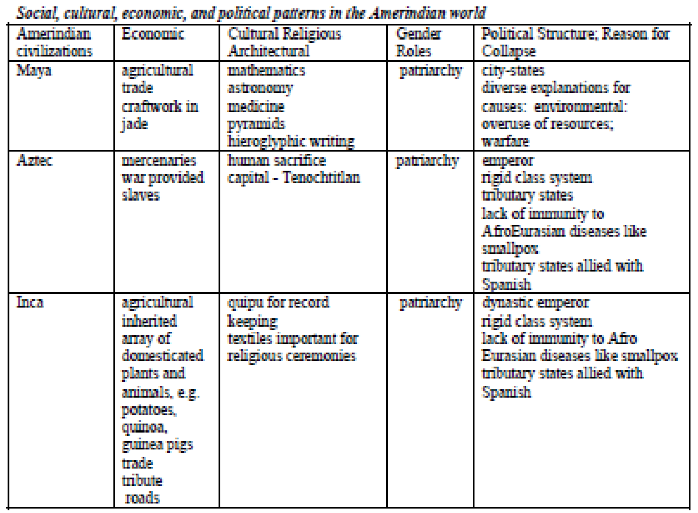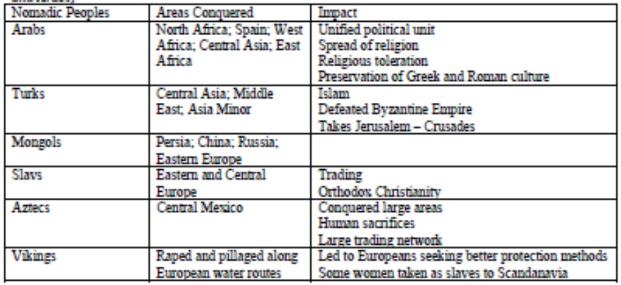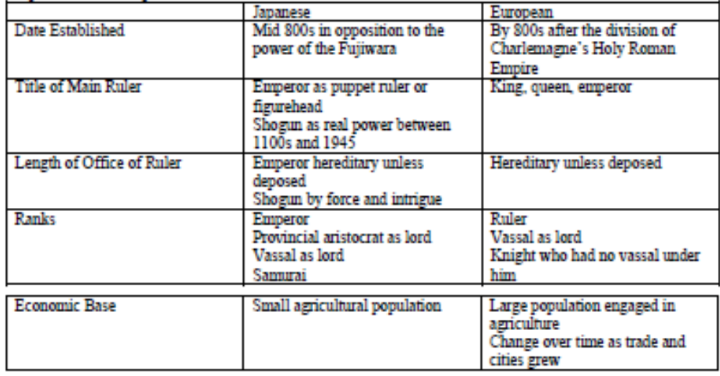cram packet 600-1450
1/28
There's no tags or description
Looks like no tags are added yet.
Name | Mastery | Learn | Test | Matching | Spaced |
|---|
No study sessions yet.
29 Terms
Major events which caused change
Islam emerges; Islamic empire emerges
Industrial Revolution in China (Sung dynasty)
Spread of Neo-Confucianism (in China) – mixture of Confucianism with some Buddhism
Schism in Christianity (when the east and the west churches divided into Roman Catholicism and Eastern Orthodox
Christianity; they divided over the issue of icons)
Camels in Sahara – increased trade
Black Death – decimated Europe’s population, political, and economic systems
Italian Renaissance – began the dominance of Europe in culture
Emergence of new empires and political systems
Tang Dynasty (618 – 906) A merit-based bureaucracy -This system was well developed during the Han Dynasty, but the Tang made good use of it by recruiting government officials who were well educated, loyal, and efficient. Although powerful families used their resources to place relatives in government positions, most bureaucrats won their posts because of intellectual ability.
Mongols
Caliphate System – religious leader and the political leader one in the same
Feudalism – King; Lords; Knights; Peasants
Continuities and breaks within the period (e.g. the impact of the Mongols on international contacts and on specific societies):
Why do historians think the following events created a new historical period?
The Byzantine Empire remained a major factor. It held numerous different groups of peoples. Bureaucracy key to success – SIMILAR TO TANG
The impact of the Viking raids – challenged Europeans to get better protection – begins European feudalism; invaded rural areas rather than large towns and cities
The Crusades – Europeans travel to Holy Land – creating a desire to Eastern goods – leads to exploration
Mongolian empires – new group of “invaders” – from Mongolia; under the leadership of Genghis Khan
Mamluk rule in Egypt (non-Arab slaves in Egypt who overthrew the Egyptians)
The rise and role of Dar al-Islam as a unifying cultural and economic force in Eurasia and Africa
Islam was a unifying force in culture aspects of Eurasia and Africa – similar religion (Islam), similar language
(Arabic), similar art (forbids art of humans so has a lot of geometric designs. COMPARE TO EUROPEAN CATHOLICISM
Islamic political structures, notably the caliphate
Caliphate was a theocracy with the political and religious leader the same. It included Sharia (Islamic Law).
Sultanate – monarch
islamic art + technology
Art: Arabesque design – geometric designs; no human figures in art
Miniature painting in Persia
Poetry
Mosques with domes, pillars, and minarets
Science: Knowledge of earth rotating on its axis and revolving around the sun
More accurate calendar than Europe’s
Improved astrolabe
Medical treatises
Use of steel for swords
Contact with Chinese brought paper and printing to the Arab world
Math: Algebra, Arabic numerals, decimal system, and concept of zero
Trans-Sahara trade
Gold, ivory, slaves and spices from below the Sahara with salt, cloth, and metalware from the Sahara
Across the Sahara between North Africa and Europe beyond to West Africa
Aided the rise of African empires and kingdoms in West Africa and spread Islam through West Africa
Indian Ocean trade
Slaves, ivory, gold, and iron from Africa; porcelain from China; pottery from Burma; cloth from India
Major route between East Africa and Asia; made possible by the monsoons; traded with China through Arabs, Indians,
Malayans, and Indonesians; lasted until 1400s when direct trade began
Brought prosperity to East Africa through the development of trading networks into the interior of the continent; set stage for the rise of African trading cities such as Sofala and Kilwa; Swahili, mix of Arabic and Bantu languages; brought Islam to coastal Bantu speakers
Silk routes
Silks and porcelain from China; woolen and linen cloth, glass, horses, ivory from other trading partners
Silk Road from China across Asia to Middle East
Spread Buddhism and Christianity; spurred European interest in finding a water route to China
Missionary outreach of major religions
Islam, Christianity, and Buddhism all had missionaries traveling through Asia
Impact of Mongol empires
Created the largest land empire in the world
Spread other cultures
Improved trade throughout Asia and eastern Europe
Paper money, banking, and letters of credit
Once areas were conquered a period of extended
peace normally resulted
Although their attacks at first disrupted the major trade routes, their rule eventually brought the Pax Mongolica, or a peace often compared to the Pax Romana established in ancient times across the Roman Empire.
The importance of the Tang and Song economic revolutions and the initiatives of the early Ming dynasty:
Paper money
Mass production of tea
Porcelain
Silk
Champa rice
Canton city in China becomes a major trading city
Exploration and trade (Zheng He)
economic revolutions of tang and song dynasties (continuity)
Increasing agricultural production - In Vietnam they made use of a new strain of fast-ripening rice that allowed the production of two crops per yr, The Tang also organized extensive irrigation systems, so that agricultural production was able to move outward from the rivers.
Increasing population
Urbanization
Technological innovations - porcelain, The Tang and Song are best known for the new technologies they invented, such as gunpowder, movable type printing, and seafaring aids, such as the magnetic compass. Gunpowder was first used in bamboo flame throwers, and by the 11th century inventors had constructed crude bombs.
Chinese influence on surrounding areas and its limits
Japan: copied Tang government, architecture, Buddhism; but NO foot binding
Conquered most of Asia
Neoconfucianism
• The conflict between Buddhism and Confucianism during the late Tang Dynasty eased under the Songs, partly because of the
development of Neo-Confucianism. Classical Confucians were concerned with practical issues of politics and morality, and
their main goal was an ordered social and political structure. Neo-Confucians also became familiar with Buddhist beliefs,
such as the nature of the soul and the individual's spiritual relationships. They came to refer to li, a concept that defined a
spiritual presence similar to the universal spirit of both Hinduism and Buddhism. This new form of Confucianism was an
important development because it reconciled Confucianism with Buddhism, and because it influenced philosophical
thought in China, Korea, Vietnam, and Japan in all subsequent eras.
Restructuring of European economic, social, and political institutions
After the fall of the Roman Empire, the Church took control of all aspects of life
European society was restructured with the Pope as the ultimate religious authority.
Feudalism rises as the main form of defense and government.
Kings and knights supported the Pope’s call for Crusades.
Crusades take many knights to the Middle East to fight
Many kings start becoming powerful
The division of Christendom into eastern and western Christian cultures
The Church was divided in 1054 over the issue of icons. Two churches emerged: Eastern Orthodox and Roman Catholic.
After the schism, the Pope continued to be head of the Roman Catholic Church and was selected only by the cardinals. The Byzantine emperor selected the patriarch.
Migration of agricultural peoples (e.g. Bantu migrations, European peoples to east/central Europe)
Bantus were agricultural people who traveled throughout Africa; spread language; slave trade networks established
Various Germanic and Slavs moved throughout Europe; caused political instability
Increased agriculture and population puts strain on the environment
Consequences of plague pandemics in the 14th century
Kills massive amounts of people – upward of 30% of population
Major changes in economic systems
Affects population centers
Growth and role of cities
Many cities became prominent due to trade (Canton, Samarkand, Timbuktu, Cairo, and Venice)
Centers of education
Cultural diffusion
What are the issues involved in using cultural areas rather than states as units of analysis?
Many areas, such as Europe, had large areas of boundaries, such as France. Studying states can be overwhelming because of the number of states involved. Cultural areas go over boundaries, but provide the ability to study a “culture” (such as Western Europe) rather than a state.
What are the sources of change: nomadic migrations versus urban growth?
Many areas, such as Song China had large amounts of growth from urbanization as did some cities of Europe. Examples of nomadic inspired growth include Mongols, Turks, and Arabs.
Was there a world economic network in this period?
There was a world economic network as far as the “known” world for different groups. Europeans had a world network in trade with Africa and Asia, but because of a lack of ability, there was not trade with the Americas or the South Pacific Islands. The Americans had a world trade system – their known world. In the next time period world exploration and trade allowed for true world trade
Were there common patterns in the new opportunities available to the constraints placed on elite women in this period?
Many women gained right to keep dowry
Managed households
Supervised education of children
Cultural patrons
Nuns
Developments in political and social institutions in both eastern and western Europe
In Western Europe the Catholic Church was a major unifying force, not so in the east.
Feudalism in the West
Compare the role and function of cities in major societies
Centers of religion, trade, government
TWO TRAVELLERS
Much of our knowledge of the world in the 13th and14th century comes from two travelers, Ibn Battuta and Marco Polo, who widened
knowledge of other cultures through their writings about their journeys.
• Marco Polo - In the late 13th century, Marco Polo left his home in Venice, and eventually traveled for many years in China. He was accompanied by his father and uncle, who were merchants anxious to stimulate trade between Venice along the trade routes east. Polo met the Chinese ruler Kublai Khan (Genghis Khan's grandson), who was interested in his travel stories and convinced him to stay as an envoy to represent him in different parts of China. He served the khan for 17 years before returning home, where he was captured by Genoans at war with Venice. While in prison, he entertained his cellmates with stories about China. One prisoner compiled the stories into a book that became wildly popular in Europe, even though many did not believe that Polo's stories were true. Europeans could not believe that the fabulous places that Polo described could ever exist.
• Ibn Battutu - This famous traveler and prolific writer of the 14th century spent many years of his life visiting many places within Islamic Empires. He was a Moroccan legal scholar who left his home for the first time to make a pilgrimage to Mecca. After his hajj was completed, he traveled through Mesopotamia and Persia, then sailed down the Red Sea and down the east African coast as far south as Kilwa. He later traveled to India, the Black Sea, Spain, Mali, and the great trading cities of Central Asia. He wrote about all of the places he traveled and compiled a detailed journal that has given historians a great deal of information about those places and their customs during the 14th century. A devout Muslim who generally expected fine hospitality, Ibn Battutu seldom kept his opinions to himself, and he commented freely on his approval or disapproval of the things that he saw.


